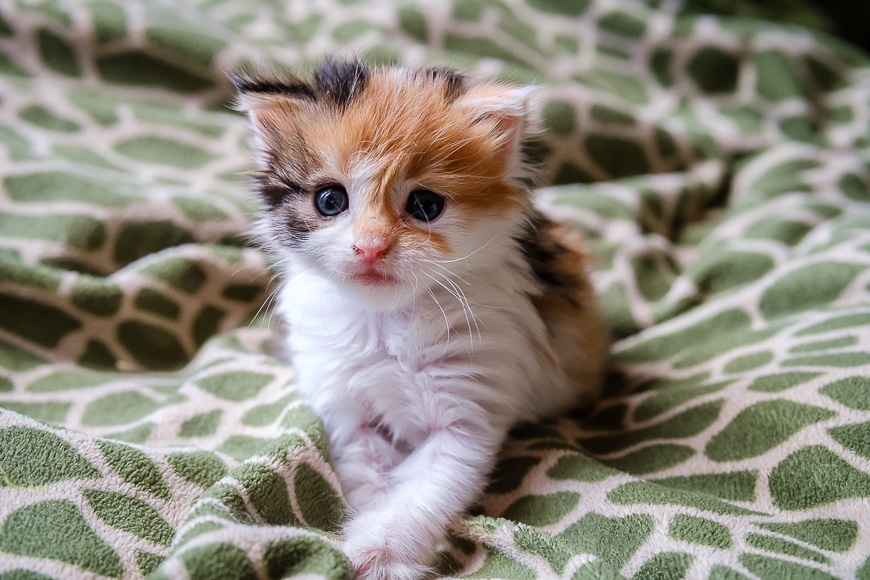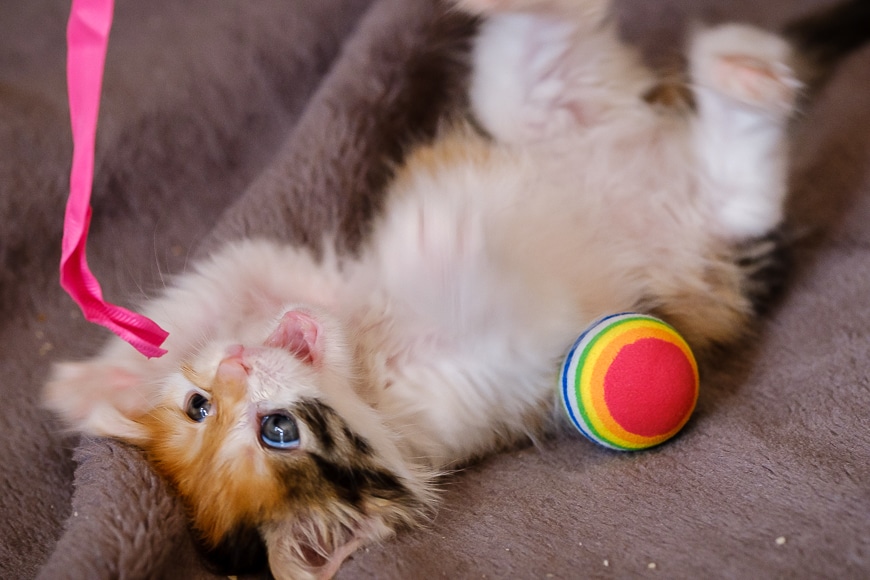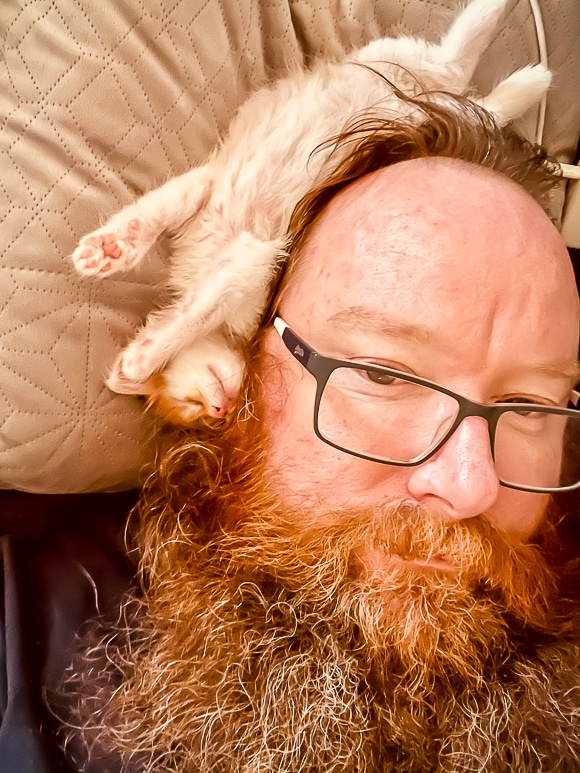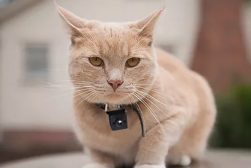
How to Get Cute Photos of Your Cat (15 Cat Photography Tips)
Want to take cute photos of your pet cat? Check out these 15 tips for cat photography at home or in a studio. Includes best hashtags and 11 cat photo ideas!
By Greg Cromie
Who doesn’t love cats and cat photos? But that begs the question of just how to get cute photos of your cats?!
In our guide, we’ll provide all the tips and tricks for getting awesome photos of cats.
(In fact, we have 15 of the best cat photography tips the Internet has ever seen!!)
There’s also a section with some cat photography ideas to get your creative juices flowing, and a bunch of hashtags to get your furry feline friends noticed on social media.
Why listen to me? Well, I have experience in this field – I’m a cat lover with three of my own fur babies.
And yes, I take LOTS of photos of my cats. I even own a pet camera so I can keep tabs on them when I’m not home.
What’s best about our guide is that you can use the same gear, tips and ideas with dogs, rabbits and tea-cup pigs – any semi-obedient animal…
Let’s dive into cuteness overload!
15 Cat Photography Tips and Tricks
1. Choose the right gear for the task

- Camera
Good news – you don’t need special photography gear to take cute photos of cats!
You can take adorable pictures with your smartphone, digital compact camera, professional DSLR or mirrorless camera. A compact camera with a zoom lens is perfect for someone new to photography.
You can zoom out for full-body shots and zoom in for close-ups of the cat’s face.
However, with a DSLR or mirrorless camera, using manual control settings makes the process of cat photography a lot easier.
Using the control dial, you select either aperture or shutter speed priority for simple operation.
Your chosen camera should also have fast autofocus to keep up with frisky cats’ quick and unpredictable movements.
- Lens
A mid-range zoom lens is best to quickly zoom in and out to keep your feline friend in the shot. I’d recommend a lens with a range of between 50mm and 200mm for cat photography.
If using a prime lens, an 85mm focal range is ideal – you’ll need to use your feet to zoom.
The final lens feature for cat photography is the aperture – the size of the contracting hole inside the lens that lets light through.
A wide aperture such as f/1.4 is a larger hole that lets in more light and produces a shallow depth of field.
A narrow aperture such as f/16 lets in less light and ensures a broad depth of field with everything in focus – provided your cat is not too close to the lens.
Learn more about depth of field in photography here.
2. Dial in your camera settings

Meet Honey Biscuit: She was an abandoned kitten that we adopted at one week old.
If you’re asking yourself, “How do I take cute pictures of my cats?” you’ve come to the right place! And to keep it simple, we’ll look at the most accessible camera settings for the job.
The best settings involve using one of two semi-auto shooting modes – Aperture Priority and Shutter Priority.
- Aperture Priority
Aperture Priority appears on the control dial as A or AV. Set the aperture manually, and the camera automatically selects the shutter speed and ISO for the lighting conditions and desired depth of field.
Too wide an aperture and your depth of field will be thin – the eyes are in focus, but the nose and ears are out of focus. A narrow aperture puts the whole scene in focus, including your cat.
Wide apertures let more light in, and a narrow aperture restricts the light. I recommend an aperture of f/2.8 or f/4 to get the face in focus and f/8 for the whole body.
You can read more about aperture priority in this guide.
- Shutter Priority
TV or S on the control dial represents shutter priority mode. Set the shutter speed, and the camera automatically sets the aperture and ISO to meet the lighting conditions.
Unless they’re asleep on the bed, cats tend to move quite fast. If they’re still, set the shutter speed between 1/60 and 1/125 of a second. For playful cats, set the shutter speed between 1/125 and 1/500 to capture the action.
A fast shutter speed lets less light in while a slower speed allows more.
3. Try and be a ‘cat person’

I’m a cat person – as in, I am a person owned by a cat!
Some consider themselves a dog person and others a cat person. And some don’t identify as either.
If you live with cats, chances are you’re already a cat person. However, if you haven’t lived with cats or don’t consider yourself a cat person, you need to adopt some characteristics to photograph them.
Cats are naturally curious, provided they’re in an environment they consider safe. If going to someone’s home to photograph the new kitty, adopt a calm and peaceful persona.
Before you pull out a camera, make sure you do the following:
- Sit on the floor and allow the kitten to come to you.
- Make them feel safe and secure by not backing them into a corner and giving them some personal space.
- Keep your voice low and assure the cat that they’re in charge here.
- Play with cat toys to awaken their curiosity.
- Consider attaching a cat collar camera so you can see what they get up to when you’re not around.
It’s now up to the kitty if they accept you in their home – that’s life with cats!
4. Be prepared for the unexpected

Cats make their own rules and won’t agree to participate in a photoshoot just because you’re ready. With cat photography, be prepared and have your gear ready to go when they finally leave the washing basket.
Chasing your cat around the house won’t end well and raises the common photographer question, “Why are cats afraid of cameras?”
Cats avoid direct eye contact, and the camera and lens represent a big eye. Also, cats are not fans of their reflections as seen in a lens.
Taking photos of cats with a smartphone doesn’t seem to have the same effect – and we always have our phones with us.
If the sun streams through a window at the same time each day, be prepared for the cat to appear and bathe in it. Sit in a good spot and when they’re in position, take the shot.
5. Focus on the eyes

This is Elfie. He’s majestically cranky.
Cats’ eyes are fascinating, beautiful and incredibly eye-catching (pardon the pun).
When photographing cats, always focus on the eyes and use the rule of thirds – the same applies to any style of portrait photography.
The rule of thirds uses two horizontal and two vertical lines to cut up the view into nine squares. Where the lines intersect are called points of interest – place one of the cat’s eyes over a point of interest for the most appealing shot.
For tips and tricks on photographing eyes close up, check out this guide.
6. Get in as close as you dare!

This is Castiel. She’s a big mama cat.
Let’s be honest; cats are the most adorable creatures on the planet – at least they think so! Get in nice and close for a full-face portrait capture.
Where possible, place the eyes over the points of interest and ensure the face and ears are in the frame.
Cats don’t like objects shoved in their face – they quickly take offence, so use a zoom lens to give the cat the space it needs while still taking a close up shot.
Call out to them and take the shot as they turn towards you.
Once you’ve earned their trust (if that ever happens!), you can get really close and try your luck with a wide angle lens – this will create a really intimate cat portrait – something that’s difficult to achieve with a longer lens.
7. Don’t forget the full-body compositions

To capture full-body cat photos, watch a lazy cat amble across the room. It’s the perfect pose for a full-body side-on shot with the legs in motion and tail swinging.
Using a cat’s (many) nap times is ideal for capturing them sprawled out on their bed – especially with shafts of light falling across their body to highlight textures and shapes in their fur.
If you have a white cat, capture him or her spread across a dark bed cover (and vice-versa for a black cat). That way you’ll get enough contrast in your image and your furry companion will stand out.
Finally, when cats lounge around outdoors, use the zoom lens to capture them asleep on the lawn or the sun-drenched pavers.
8. Shoot from various angles for variety

Cats look majestic from any angle – use this to your advantage when you capture cat pictures.
Shoot from above eye level for adorable cat photos where the head appears slightly more prominent when compared to the body in the background.
If you have a scratching post or fence that your cat likes to observe their kingdom from, get down low and shoot up. They’ll appear regal and focused on a distant point of interest.
Make sure you get down at eye level to take eye-to-eye photos of your black and white puss.
The photo above was taken from beneath the cat’s eye level, giving him a well-deserved sense of dominance!
9. Use continuous shooting modes to keep up with the action

Even with a fast shutter speed, we often miss the best moments when taking cat pictures.
Fortunately, most cameras have a continuous shooting mode where you press the shutter button once, and the camera takes a fast burst of photos. This is great for pet photography.
Make sure to use the electronic shutter for a silent operation that won’t spook your cat – the mechanical shutter is noisy and distracts your cat.
If you’re using an iPhone, one tip to capture a good shot is to use Timer Mode, which takes 10 photos in quick succession, leaving you to choose the best image and delete the rest.
10. Take your time

Any cat person will tell you that cats don’t follow human timeframes or expectations.
Cat photography requires an element of patience and the ability to lounge around like a cat waiting for the right moment to pounce!
If you know the sunlit floor will soon attract the cat, get comfortable and wait for the right time.
Obviously, if you’re the owner of your cat, you can leave a camera at arm’s reach from your sofa, ready to take a photo at just the right moment at some point in the day.
If you’ve been hired to do a cat photoshoot, you may not have the luxury of time, so just do the best you can… or turn up a bit early.
11. Curiosity captured the cat!

Cat lovers will also tell you that cats are curious about their surroundings.
The slightest breeze pushing a dust bunny across the room is cause for inspection. Make the most of this and find ways to bring out your cat’s natural curiosity.
A curious cat appears more active with purposeful movements, straight whiskers, pricked-up ears and wide eyes – all of which look great when captured in a photo.
To help your cat’s modelling career, use cat toys to activate hunting mode! The ears will flatten, the eyes bulge, and they drop their belly to the floor.
(If lucky, you’ll even get that funny little bottom wiggle the moment before they pounce!)
Alternatively, entice your cat to jump and flip by holding a toy above its head and out of the camera’s view.
12. Don’t use flash

Two commonly asked questions I see in photography forums are: “Is it ok to use flash on cats?” and “Why do cats eyes glow with flash?”
Animals don’t understand why a flash of light is occurring, and it can scare your pet or impact its sense of safety in the home. Avoid using a flash when taking photos of your kitty or any other animal.
Besides, cats hiding in the shadows can create moody images.
Flash photography often results in photos where the cat’s eyes appear as glowing lights. This unappealing effect happens because the flash of light reflects off the back of the eyeball.
13. Photograph cats in their safe-place

Most cats, especially those that are always indoors, get spooked by the world outside their door.
Anyone photographing animals gets the best out of a kitten or dog when they’re in their safe place. Home is where kittens feel safest and the best place for capturing amazing photos of them.
If you’re fortunate enough to have a garden, make sure you give them time to roam free and be ready with your camera.
14. Photograph cats in a studio

Another common question by photographers is, “How do you photograph a cat in a studio?” The answer is, “With great difficulty!”.
Taking your cat to a studio for a professional photographer to do their magic is a special kind of madness. In some cases, it works – but the photographer is a cat person and experienced in keeping pets calm and feeling safe.
For studio-quality photos taken by a professional photographer, get them to work in your home and set up equipment in a space familiar to your pet.
Here’s some information on studio lights for your next cat photoshoot.
15. Volunteer at a cat shelter

If you love cats like I do, but don’t have a kitty of your own, consider working at a local animal shelter or pet rescue centre.
Most big cities have pet rescue and adoption centres where the adoptive animals appear on a website. Volunteer at a local centre to take portrait pictures of the cats so their online profile can attract the right future owner.
Alternatively, if your city has a cat café, drop by for an hour or two to hang out with some new furry friends.
11 Quick Cat Photography Ideas
I’ve lived with several fur babies and have had a lot of experience taking cat pictures.
Here are some of my best ideas, tips and tricks if you want to capture great photos of your feline overlords!
- Cats love to sleep – between 12 and 16 hours a day. Capture images of your cat while they slumber on the bed or a big fluffy blanket.
- Felines lounge in the sun to keep their body temperature up while they sleep. Sunlight is ideal for great photos of your cats – the cat’s colours will pop in the sunlight.
- If your fur baby likes to sit on the window sill, capture them from behind for a silhouette.
- With a cat sitting inside a window, take the photo from the outside. That way, you have the cat and the reflection in the same photo.
- Cats spend around five hours a day cleaning and grooming themselves. While they’re sitting still with their leg in the air, take a photo or two.
- Felines make it obvious when they’re about to pounce – eyes wide, ears back and a wiggling bottom. Be ready to take a photo of where they aim to land.
- If you have an outdoor cat, take photos of them exploring the garden. Get down at eye level with shrubs and bushes framing the shot.
- If you have access to a lightbox, sit the cat on it to have light point up – they’ll look like a feline God!
- Make sure your background is clutter-free, so the stunning features of your cat pop in the picture.
- Kittens are exquisite – make the most of the early months and take a photo a day to track their growth.
- If you have a mix of animals that get along, try and get a group shot of the whole fur family.
26 Cat Photography hashtags
Is it just me, or is Instagram in love with cat photos? If you’re a photographer that loves to share the odd photo of cats on social media, you’ll need to tag them correctly.
Fortunately, we have the most up-to-date list of the best cat photography hashtags.
- #catphotography
- #cats
- #cat
- #catsofinstagram
- #catlife
- #catstagram
- #catlovers
- #catphoto
- #catlover
- #catoftheday
- #instacat
- #meow
- #catlove
- #kitty
- #catloversclub
- #kitten
- #photography
- #cutecat
- #kittens
- #cutecats
- #petsofinstagram
- #cute
- #pets
- #catworld
- #kittensofinstagram
See more photographer Instagram hashtags here.
Final Words

Biscuit and I both have ginger fur on our faces.
As a cat person, I have an obligation to say that cats are the supreme overlords of most houses they choose to live in.
After all, they poop in a box… and we faithfully clean it up!
In case you were wondering, the models for this article are all mine – Castiel (big grey girl), Elfie (fluffy grey boy) and Biscuit (ginger, black and white baby girl). I also have a dog named Yuki.
The other cats I photographed at the Melbourne Cat Cafe. The featured image of Biscuit in the orange teacup was taken when she was two weeks old – that’s a normal size teacup.
Cats make for funny and exciting subjects to photography every day. They have unique personalities and some quirky character traits that only their owners understand.
Are you a cat person or a dog person? Do you love taking a photo of your cat’s face to share with friends online?
What have been your experiences with taking photos of your favourites felines?
Share your comments and questions below to be part of the conversation. Happy Shooting. Meow.


Check out these 8 essential tools to help you succeed as a professional photographer.
Includes limited-time discounts.














